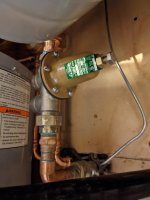MichaelOdza
New Member
20+ year old water heater started leaking, was replaced with new one. Pressure relief valve was new about two years ago. Checked its pressure with a tire gauge, seemed fine. Plumber added expansion tank per code. Immediately started hearing loud noises every few hours (randomly), even through the night when no one is using water. Starts with a rising whistling wind-like noise, then erupts into loud bangs, rattles, groans. When we shut off the valve on the line bringing cold water into the new heater, no noise. Shut off whole house water valve, noises continue. No visible leaks or hot spots. We paid a sonic leak detection company which reported they could hear no leaks, and nitrogen pressure test confirmed. Yet when we've had the intake valve shut off overnight (so we can sleep), and open it again, we hear a few seconds of water trickling in, which seems to indicate that the level in the brand new water tank has dropped. Where could the water be going?
We've opened all the hot water (and cold) taps in the house and let them run a few times, and occasionally get some gurgling at one of the taps but not always. The plumber added a vertical foot or so of pipe to the intake pipe to arrest water hammer -- made no difference.
We've opened all the hot water (and cold) taps in the house and let them run a few times, and occasionally get some gurgling at one of the taps but not always. The plumber added a vertical foot or so of pipe to the intake pipe to arrest water hammer -- made no difference.

